Sunflower (Helianthus) is a tall annual or perennial flower with one or more wide flower heads and fantastic bright yellow or red petals. They bloom in summer, and you can see 1,000 to 4,000 tiny individual flowers in each head.
However, it is not only beautiful but a beneficial plant. Thanks to Russian botanists, who discovered that oil from the pressed seeds is a delicious replacement for lard and butter during the Fast, we use this oil in daily nutrition nowadays.
History of Sunflowers
One of the first American beauties the first Europeans saw when arrived at the new continent were sunflowers growing all around. Plant historians believe that Native Americans have been cultivating sunflowers for 4,000 years in the Southwest region and the Mississippi River valley.
Indians planted various annual and perennial species of sunflowers and used raw or roasted seeds for medical purposes and as food (they made bread or gruel from dried grains of sunflower).
Moreover, they pressed the plant’s seeds and used the so-obtained oil as a skin lotion or prepared the flower petals and seeds to get yellow, blue, and black dye for color clothing and body paint.
After understanding the value of sunflowers, the European settlers sent its seeds back to Europe. All of a sudden, English cottage gardens were full of these fantastic plants, and in Russian land, it became a significant agricultural crop as a source of edible oil.
Thanks for Germany, the US, and Japan breeders, sunflowers have become an ornamental plant nowadays. You just need to give the sunflowers enough space and they will grow themselves wherever you want.
Why We Should Plant Sunflowers
1. Feed useful pollinators
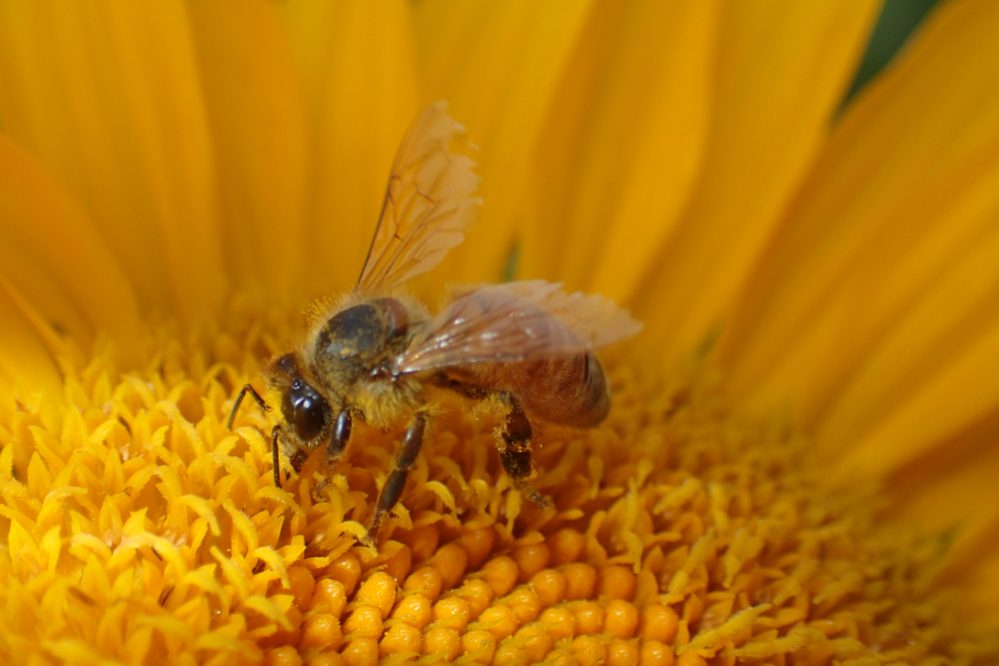
Thanks to its large outer petals, sunflowers attract bees. Honey bees and even bumblebees can find a valuable source of nectar and pollen in the center of thousands of tiny florets these flowers contain.
If you are thinking to include sunflowers in your garden, try to buy non-GMO seedlings or plants grown without chemicals. Otherwise, seeds usually contain toxic chemicals (neonicotinoids) that will kill most of the important pollinators. Simply said, bees prefer organic.
2. Easy to grow
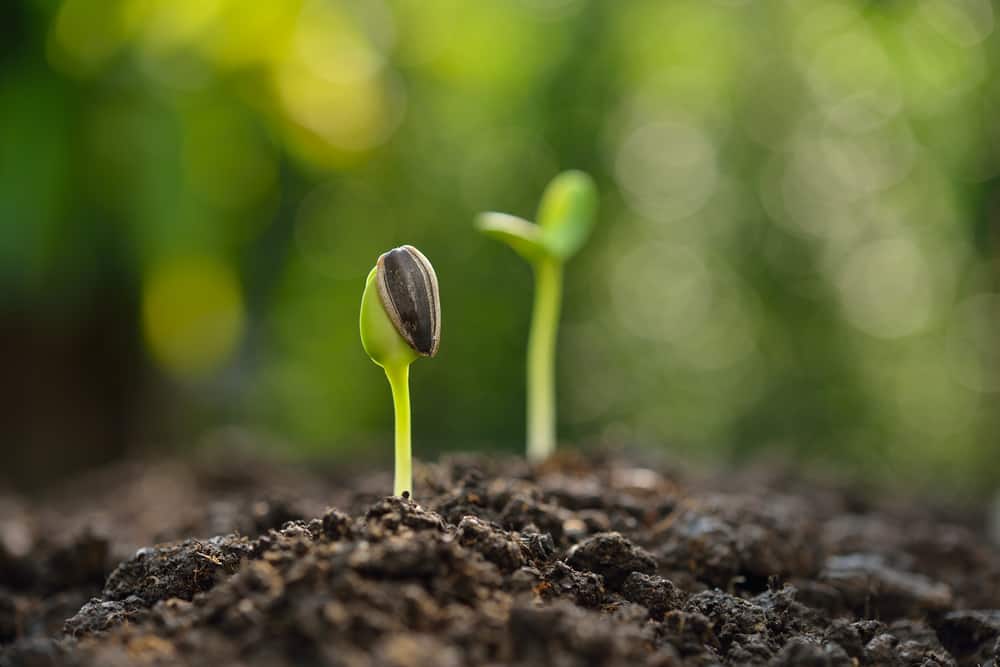
There are probably no flowers that are easier to cultivate than sunflowers. They can grow in dirt, along the road, even on the poor soil. If you want to beautify your garden, you just need to put seeds in an inch deep hole and let the plant roots grow wide.
The only difference between the sunflowers that grow on poor or fertilized soil is the size of their blooms. For larger ones, you need to provide more fertile ground.
3. Provide shade in your garden
Try to plant sunflowers on the way to provide necessary shade to other plants, especially if you live in the region with hot summers. To get a full benefit from the big sunflower blooms and foliage, don’t forget to prune lower leaves to allow veggies access to sunflower stems.
4. Detox your contaminated soil
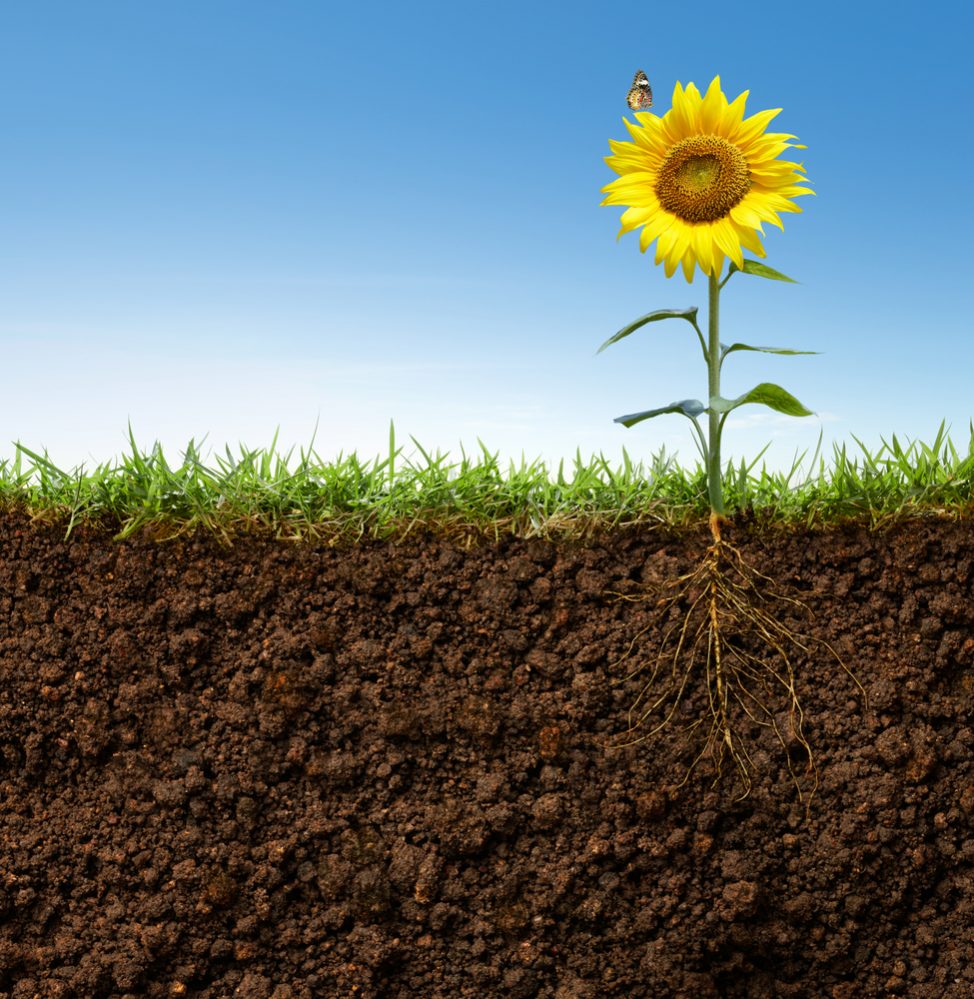
If the soil in your garden is contaminated or located in an urban area, you should plant sunflowers as a natural solution for heavy metals detoxification.
This plant is often used as a ‘hyper-accumulator’ and ‘phytoremediator’ (plant remedy) which means that it can absorb most of the poisonous chemicals and toxic heavy metals from the soil.
The list is pretty long and includes manganese, lead, chromium, arsenic, copper, zinc, and cadmium. Believe it or not, this plant was used to absorb toxic substances after nuclear disasters in both Chernobyl and Fukushima.
It’s just up to you to estimate how many flowers you need to plant concerning the size of your garden and the pollution of the environment you live in.
5. Delicious edible seeds

You can find two types of sunflower seeds, black (higher in oil) and grey striped (it tastes better). Both varieties of seeds are a good source of selenium, magnesium, and vitamin E.
6. A great trellis for your other plants
Since these flowers grow tall, you can use them as a trellis for other veggies in your garden such as cucumbers, melons, or squashes. For these vegetables, every sunflower is a natural trellis which can help keep them up off the ground. That way, veggies are healthier and grow vertically, protected from moist soil and pests.
7. Attract birds to your garden
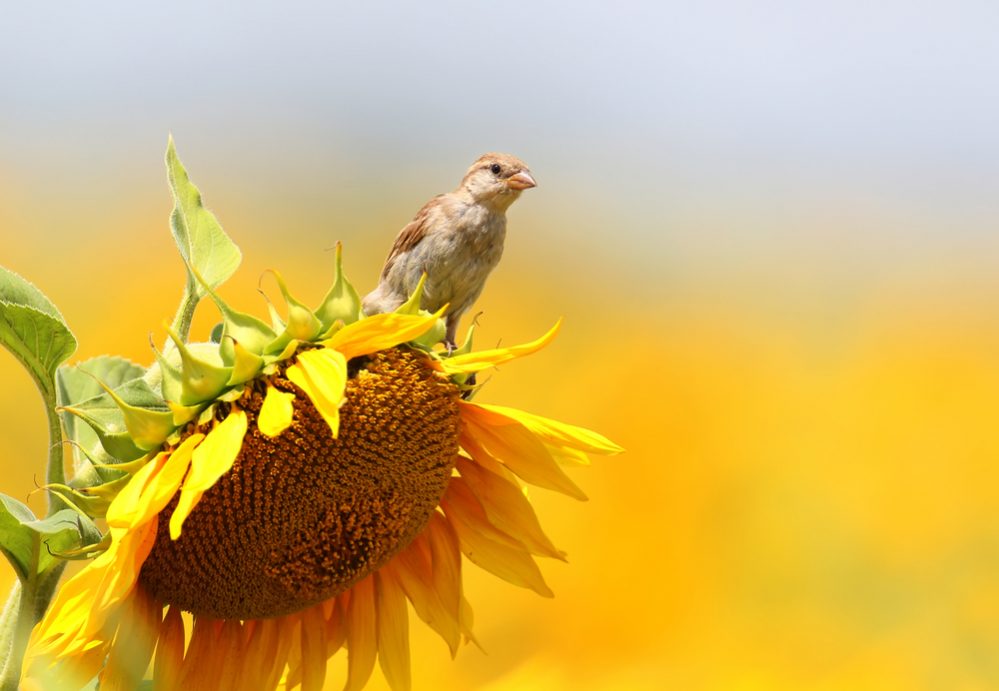
Since birds control pests and keep a balance between harmful and beneficial insects in your garden, you want to welcome ‘good guys’. Growing sunflowers is one of the best possible ways to provide birds with adequate conditions that will attract them to come. In other words, they just adore sunflower seeds!
Don’t forget to leave some dry sunflower heads in the garden during cold winter. That way, birds will often visit your garden throughout the year and clean it from pests during the summer when your garden needs it the most.
Also, add some bird baths between your plants and let your new flying friends take a bath, drink, and keep ‘bad’ insects under control.
8. Beautiful cut flowers
The sunflower blooms look stunning and beautiful in your garden, but they are also gorgeous as cut flowers. That way, you will get fragrant, cheerful, and amazingly decorated home without too much effort. Just remember, Vincent van Gogh knew why back in the 19th century!
Sunflower Varieties
People grow approximately 67 different types of this beautiful flower all around the globe, including dwarf varieties. Pick out your favorite variety from the list I provide to you and enrich your garden.
1. Giant Sungold
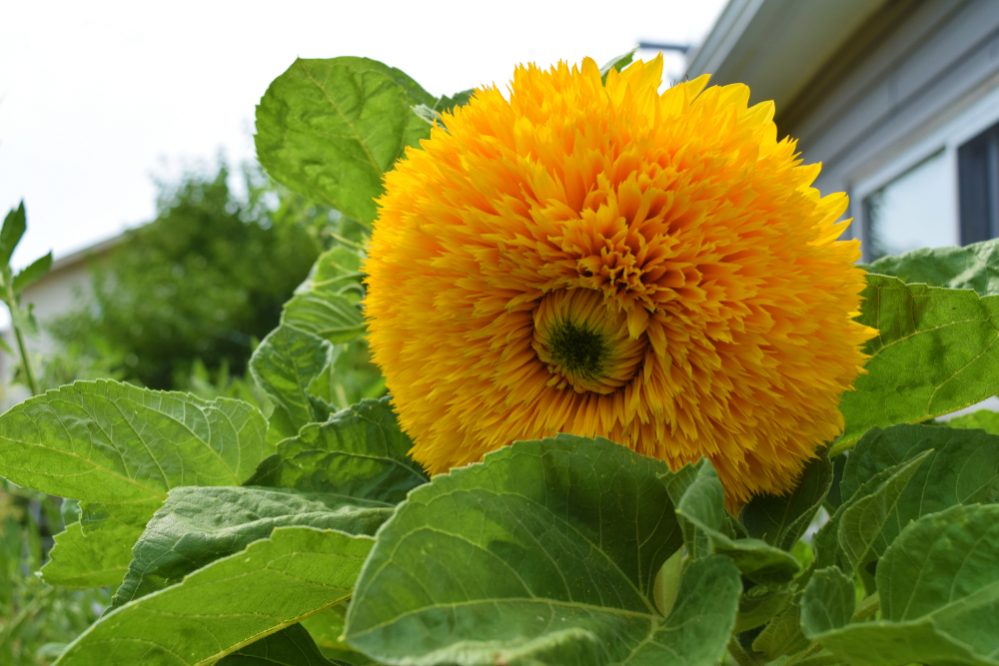
Basically, it is just a taller version of small, two to three feet (60-90 cm) tall, deep-gold, and fluffy ‘Teddy bear’ sunflower. This unique sunflower is well-known as a double bloomer. It stands six feet (1.8 m) tall, with a head that is big and puffy and the whole plant looks like a giant dandelion.
2. Mammoth Russian
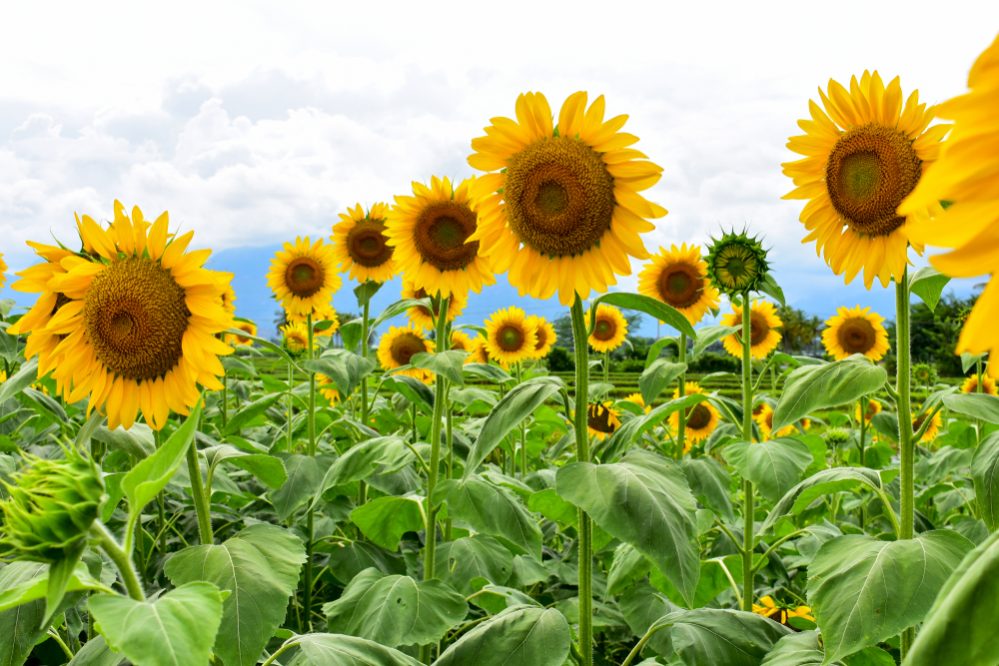
A lot of people grow sunflowers because of their sheer size. They are hard not to notice when they are incredibly tall and grow up to twelve feet (3.7 m) in height. This variety produces big, bold, colorful heads full of striped, large seeds. You can’t mistakenly replace it with any other seeds.
3. Strawberry blonde
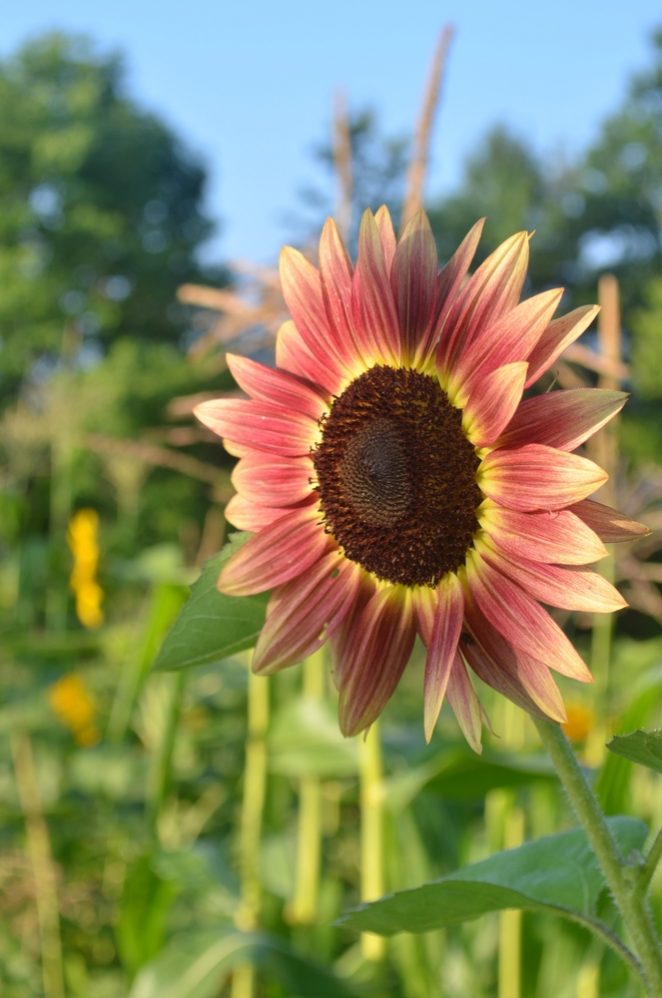
This sunflower is multicolored and about six feet (1.8 m) tall. Enjoy their reddish-pink bloom with cheerful yellow tips.
4. Moulin Rouge
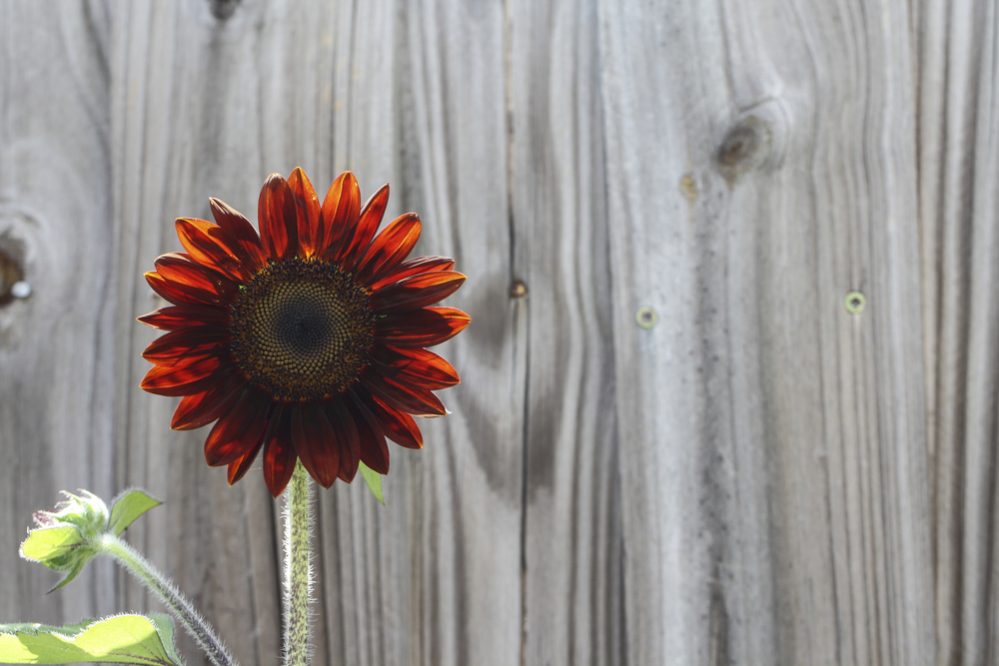
Yes, they are dark red with an entirely daring bloom. Believe it or not, you will quickly notice this unique flower in the garden, although it is only four feet (1.2 m) tall.
5. Italian white
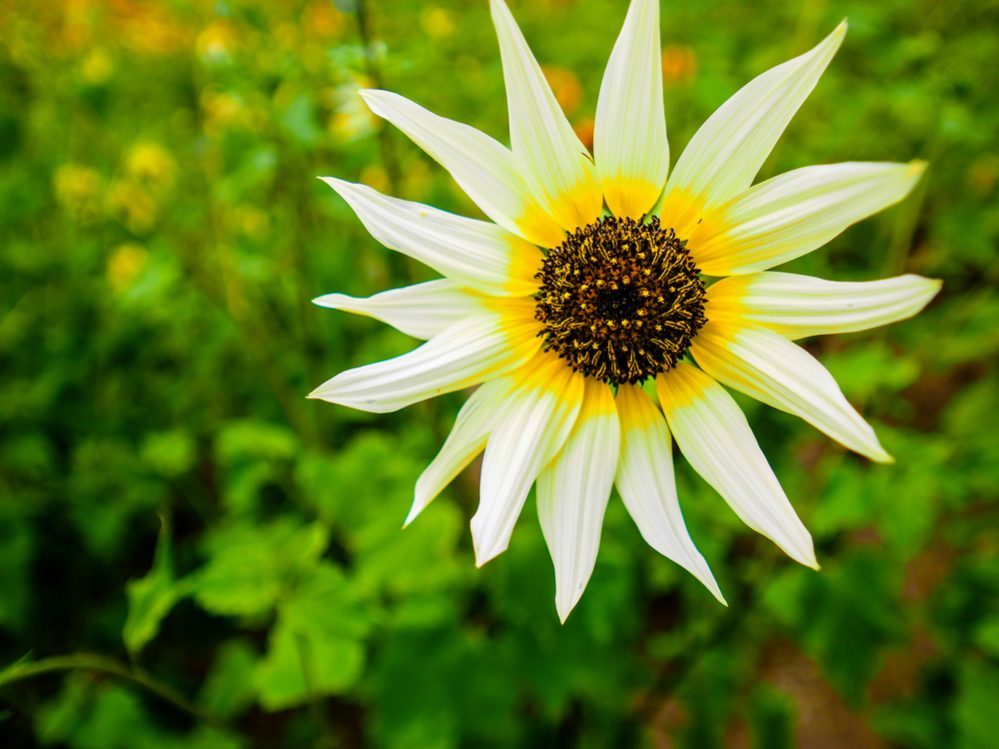
This variety is not flashy, but it is elegant and tall. Imagine the gorgeous beauty of a large dark colored center surrounded with four-inch (10 cm) white blooms at the top of the five to seven feet (1.5-2 m) high stems. The bonus is that this variety produces multiple flowers during each growing season.
6. Sunbeams
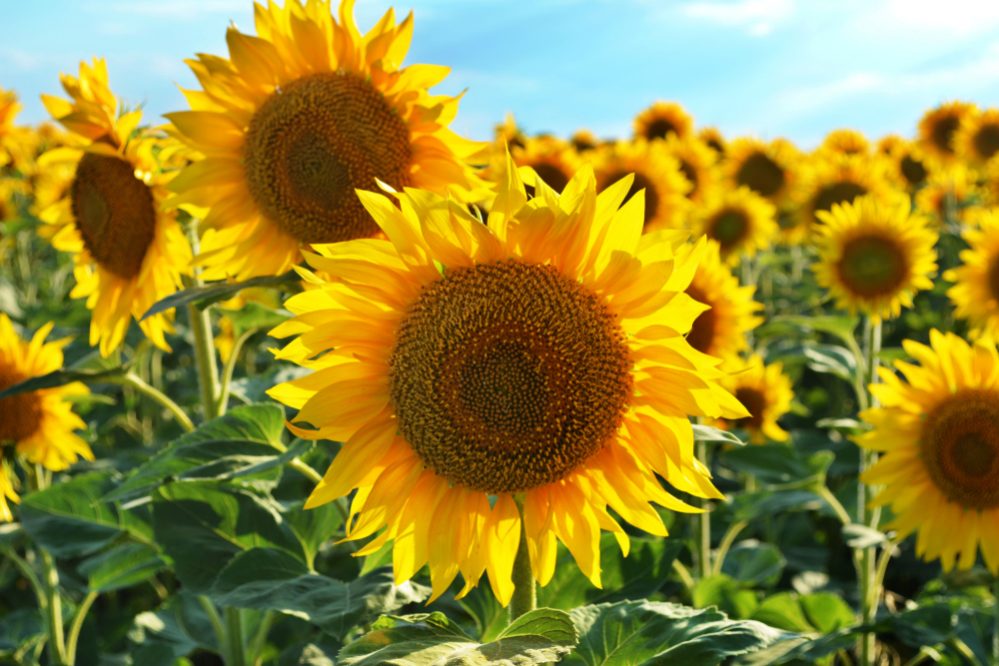
Yes, that is the famous van Gogh sunflower! This exceptional 5-inch (13 cm) bouquet flowers grow on an approximately 5-feet tall plant (1.5 m). Although its golden-yellow petals are not rich and thick, and flowers are entirely pollenless, this type of sunflower is something special. You need to plant it in your garden for pure pleasure.
7. Little Becka
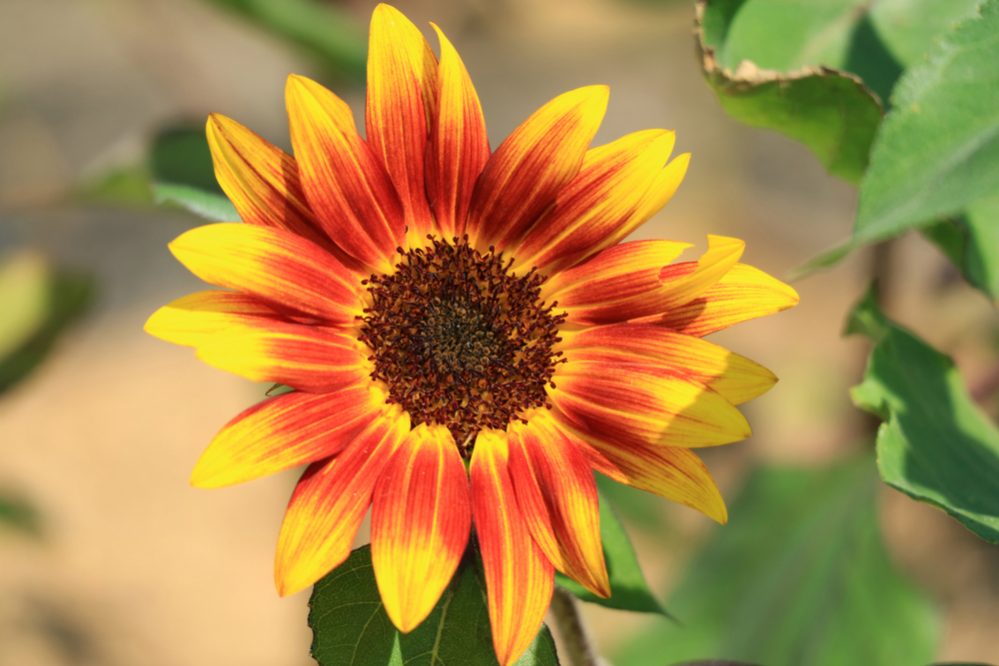
This dwarf sunflower variety grows up to three feet (0.9 m), but the gorgeous colorful bloom will leave you breathless. Enjoy its unique crimson-red color, with bright golden base and tops petals.
How to Plant Sunflowers in Your Garden
As I already said, it is pretty easy growing these gentle giants, and you should plant them to make a barrier for squirrels and birds which steal the sown seeds in your garden. Once the plant grows, it is entirely sun-tolerant and requires very little care. Just don’t forget to sow new seeds every year.
Step 1. Prepare the area
When deciding to choose the right place for sunflowers, keep in mind that they need a minimum six to eight hours of direct sunlight daily to reach their maximum potential. Also, keep them away from windy areas.
Pick out a well-drained location and dig two feet (60 cm) deep hole. You want to sow your seeds in the soil previously fertilized with compost or a slow release (granular or an organic) fertilizer about eight inches (20 cm) beneath the surface.
Step 2. Plant the sunflower seeds
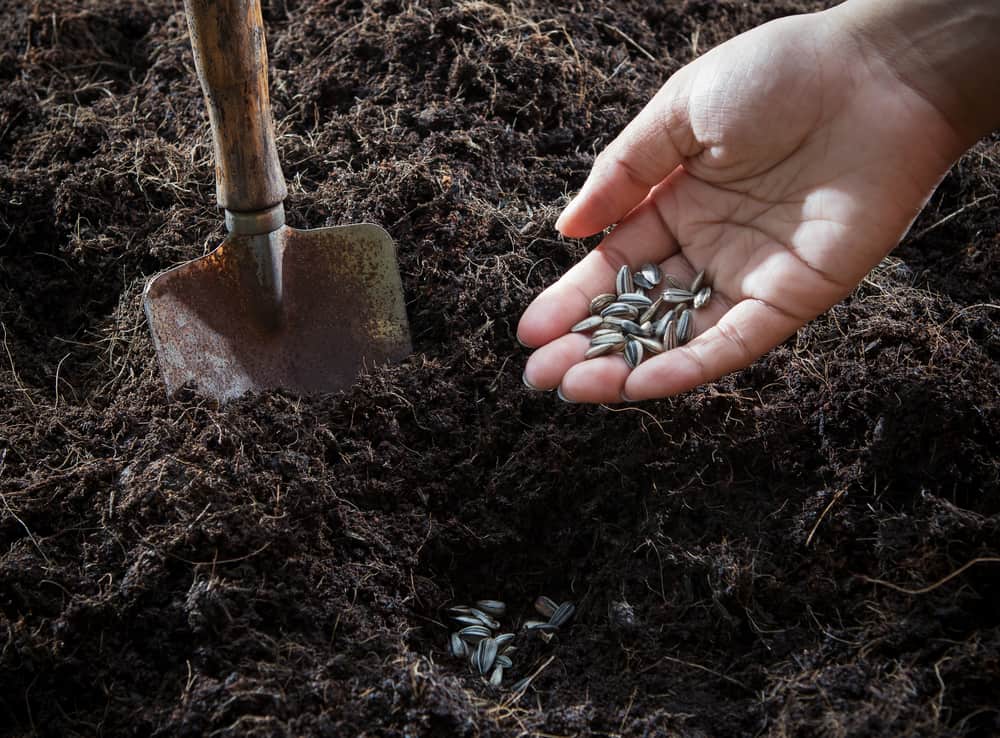
Wait the period after danger of frost is past and the soil temperature is not less than 55-60 F (12.8-15.5 C). You can expect the best germination rates when the temperatures of the soil are 70 to 75 F (21-25 C)
Put seeds 1 to 3 inches (2.5-7.5 cm) deep in the ground. If you want to get taller varieties, you should try to sow them to about 1.5 feet (45.5 cm) apart. For the lower types, it is enough to leave about one foot (30 cm) between stems. In the beginning, you should use row covers to protect young plants.
Step 3. Care your sunflowers
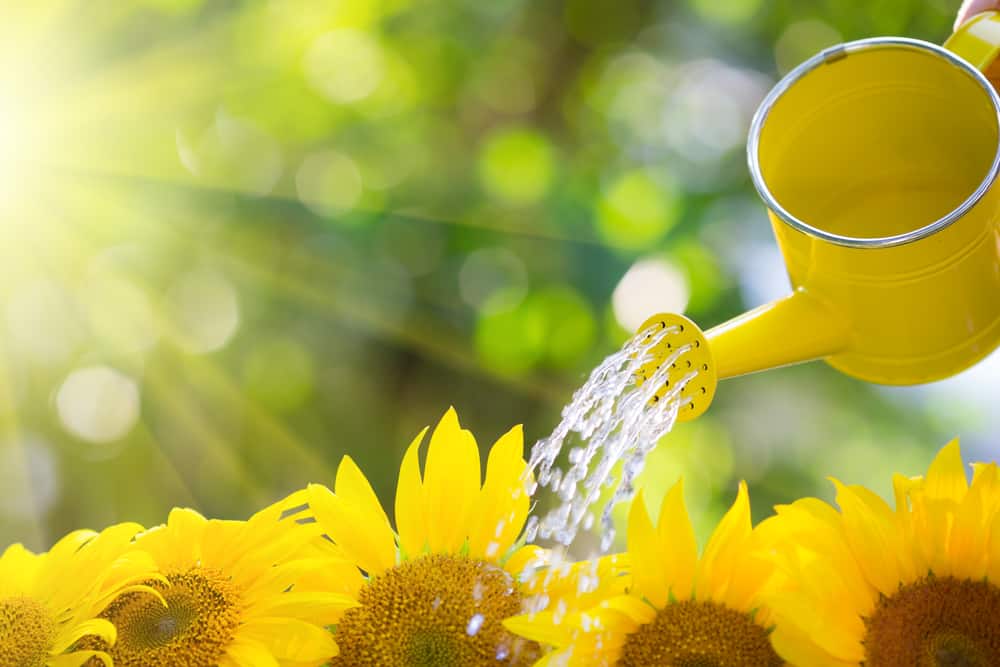
- Watering – While your sunflowers are small, you should water them daily, about 3 to 4 inches (7.5-10 cm) around their root zone. They need water to grow fast and become strong. Once your plants are established, they don’t need a lot of watering because they can deal well with drier conditions. Water them once a week, preferably in the morning, with two gallons (7.5 liters) of liquid but deeply to encourage deeper rooting.
- Fertilizing – Be frugal with fertilizer. Actually, avoid fertilizing your plants once you planted them. If the soil is really poor, you can fertilize your sunflowers once a month, but be careful because fertilizer mustn’t touch the base of the stem. The wise way is to dig a circle around the sunflower and fill it with a slow-release fertilizer. When you add water, it will bring the fertilizer to your plant without destroying its base. That way, you will prevent breaking stems in the fall.
- Staking – If you have planted taller varieties of these flowers, don’t forget to support them with stakes. That way, you will prevent breaking the stems once when blooms are big, full of seeds, and heavy. An average bamboo stick and bailing twine are enough to do a job well.
- Mulching – Applying mulch around the sunflower’s base will hold the soil moisture and prevent weeds from growing at the same time. You just need to place a few inches (minimum 5 cm) thick layers of mulch around each plant’s base.
- Pruning and trimming – If you want to get more flowers, you should prune your annual sunflowers. When the main bloom bud forms, you should cut it. That way, you will reduce the plant’s height, but you will get bushier flowers. When the time comes, you need to trim sunflower heads and collect the seeds.
Good and Bad Companions
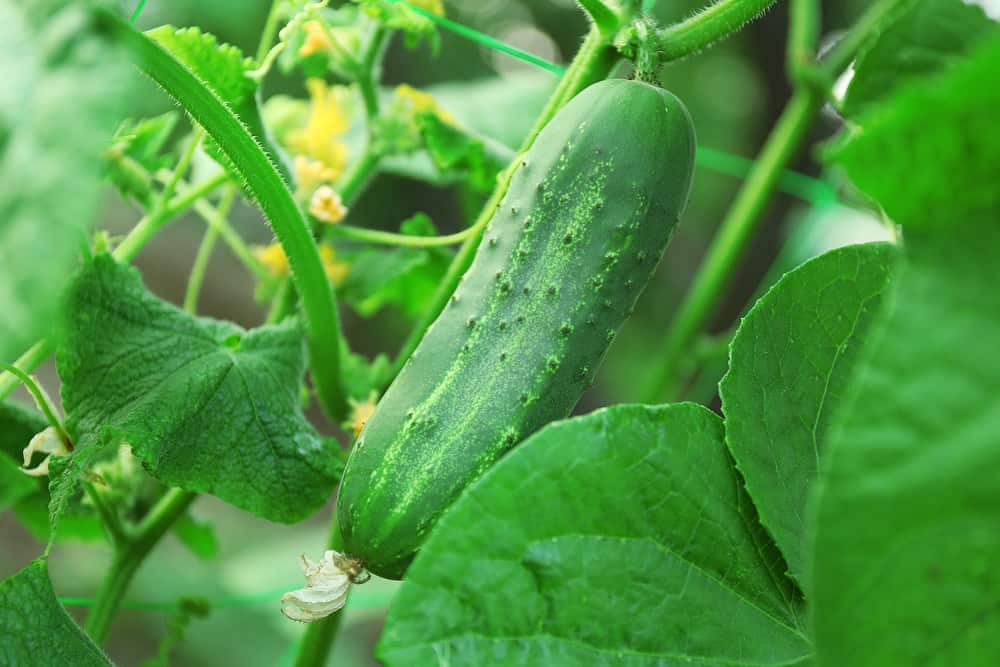
Have you ever heard about allelopathy? This biological phenomenon means that one plant produces biochemicals that influence the other plant’s growth, development, and reproduction. Keep in mind that your beautiful sunflowers can encourage or inhibit growth in some other plants. Therefore, be careful while planning your new garden.
Good companion plants for sunflowers:
- Cucumbers, vine, and corn (sunflowers are natural trellises for these plants)
- Bush beans (they produce nitrogen and won’t compete with sunflowers for nutrients)
- Lettuce, peppers, soybeans, and tomatoes (sunflowers provide necessary shade for these plants)
- Zucchini, squashes, and pumpkins (sunflowers protect these plants from aphids)
Bad companion plants for sunflowers:
- Potatoes and pole beans (sunflowers and these plants inhibit growth to each other)
Sunflowers Pests and Diseases
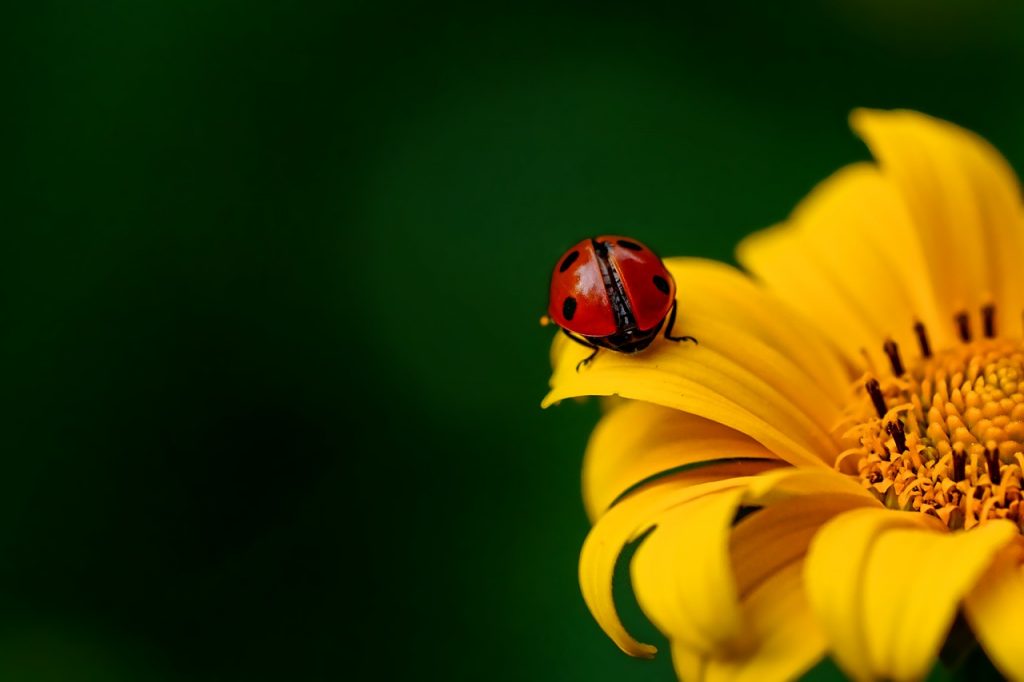
Sunflowers are usually insect-free plants, but some pests and diseases can harm these gorgeous giants.
- Empty seeds – That is not a rare occurrence when autumn comes too soon. In that case, the only prevention is earlier planting.
- Small gray moths – It can lay its eggs in the sunflowers’ blossoms. Quickly solve the problem by picking up the worms from the flowers.
- Leaf Mottle – This fungus forms in the ground. The only solution is rotating your crops.
- Rust – This menace will cause curved and deformed sunflower’s leaves with red bumps or yellow spots. Rust won’t kill a flower, but it will decrease its health. Plus, once this menace develops, you will hardly get rid of it. As prevention, don’t leave the leaves wet during watering. Once it appears, you need to remove affected areas and treat the plants with a fungicide.
- Powdery Mildew – After this fungus affects your plant, its leaves will look like sprinkled with powdered sugar. Over time it will dry up and fall off. To get rid of it, remove affected parts and use a fungicide.
- Birds – They like your sunflowers’ seeds. On the one hand, your flowers attract birds, and they will save your garden from pests naturally. On the other hand, they will eat all the seeds, and that can be inconvenient if you want to use them. Covering the planted seeds and the fully developed sunflower heads are the only solutions for this issue.
Summary
If you plan to plant sunflowers to get your own oil, you need to determine the ideal time for harvesting. The best indicators that it is the harvest time are the appearance of the brown stalks and the flower heads that begin to lean toward the ground.
If you grow sunflowers only because of their beauty, you can leave them in the garden over winter and let birds eat seeds. That way you will attract them and get natural protection for your other plants.
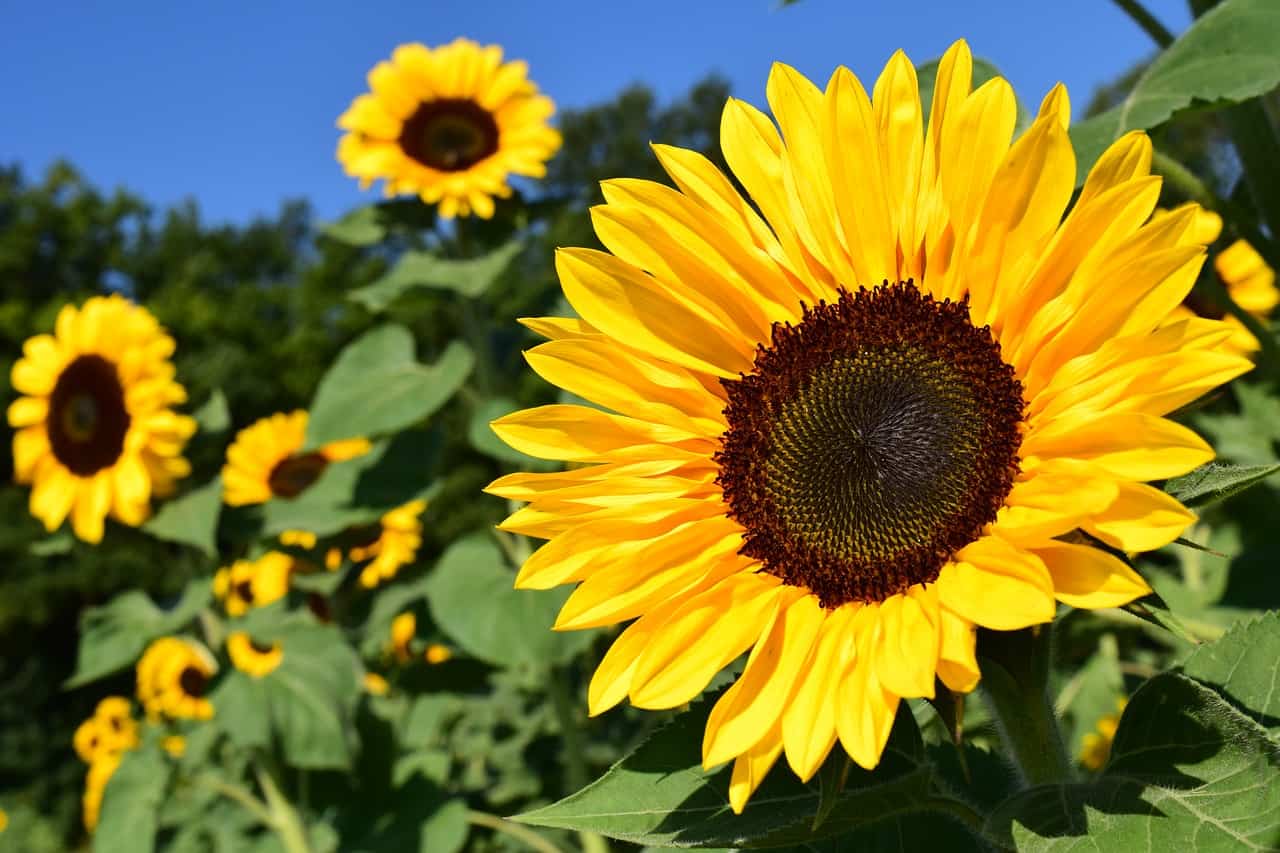
Hey, Peter, thanks! very well written and informative post.
Would tell me how to revive a dying sunflower plant?
This is my first year growing sunflowers. To my surprise. The plants grew 8 ft. tall. Not all, but most. Next year I will get different varieties of sunflower plants .
Can I use organice chicken manure for my potted tomaty and sunflowers in my any advice would be helpful THANK YOu?
First of all, I would like to say thanks to you for such a nice and informative article about the sunflower. I love sunflower so much. I was thinking to grow sunflower in my garden. But I’m totally new about it. I’ve got huge information on this post. Your article will help me a lot to grow a sunflower in my garden. Thanks again for your effort to write such a nice and informative post.
I used to always tuck plant sunflowers around my garden and haven’t done it for the last few years for some reason. Thanks for the motivation. I might even try some of these beautiful, less common varieties you are showing.
I have grown sunflowers for a pet bird. The problem is that about 50% of the seeds are empty, nothing inside the shell. any suggestions as to what to do or what causes this problem?
The main reasons are:
1. Pollination problems
2. Lack of fertilizer